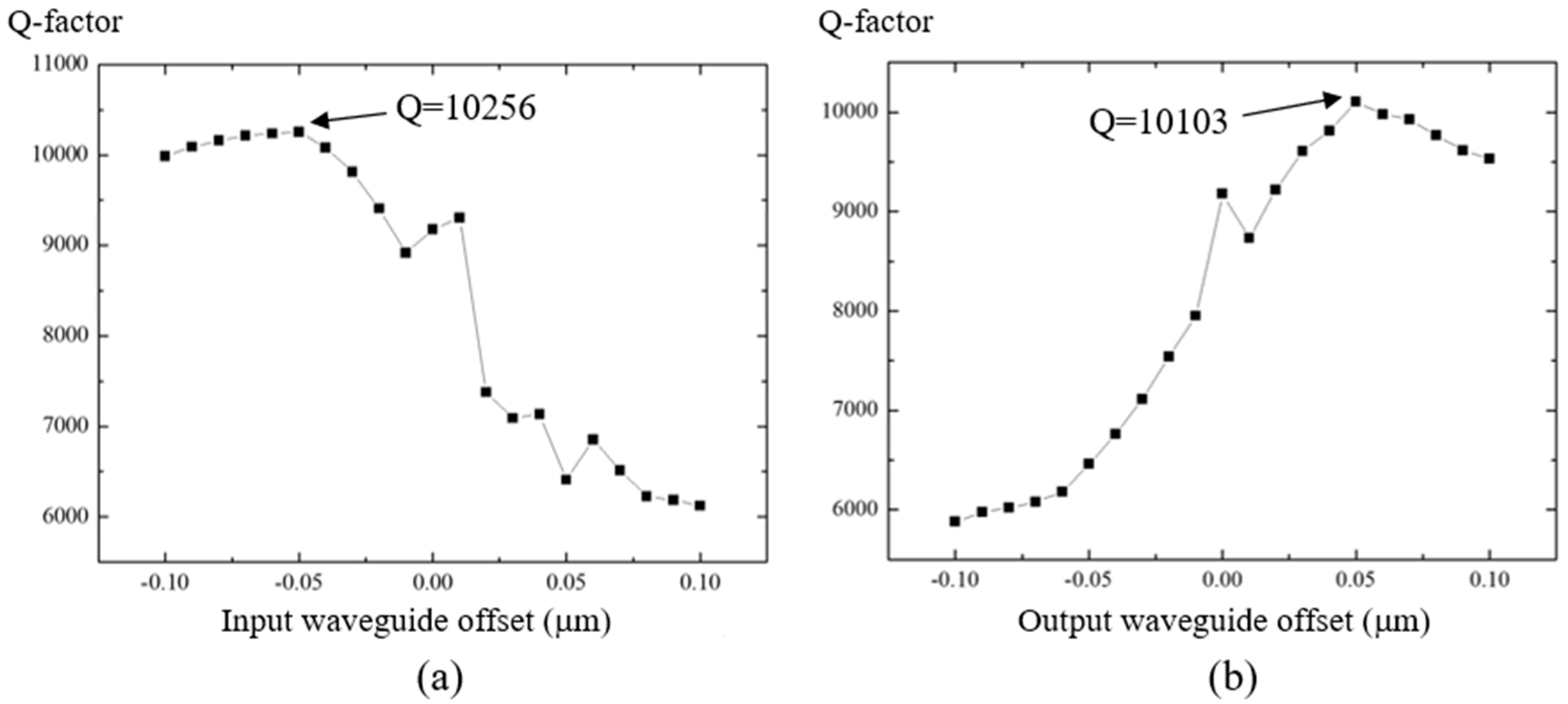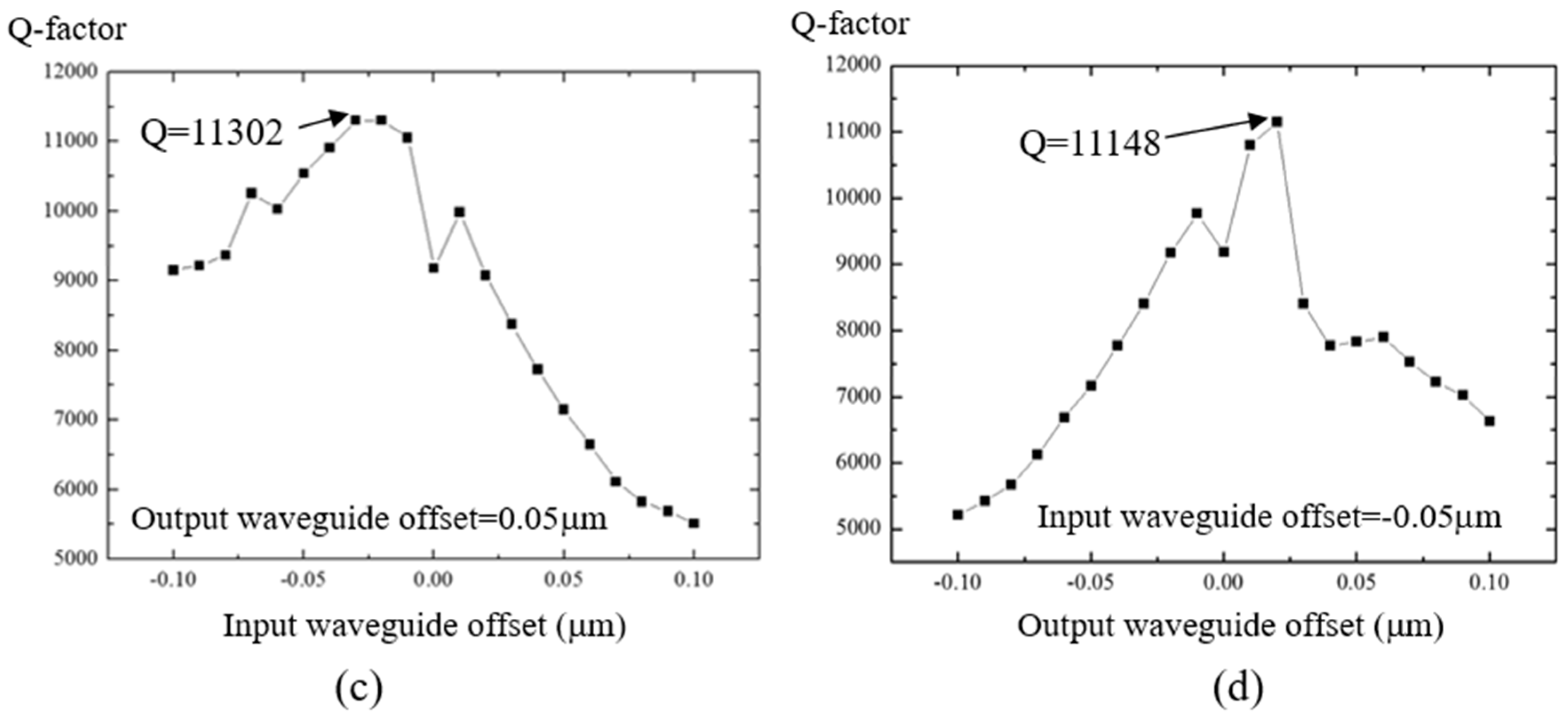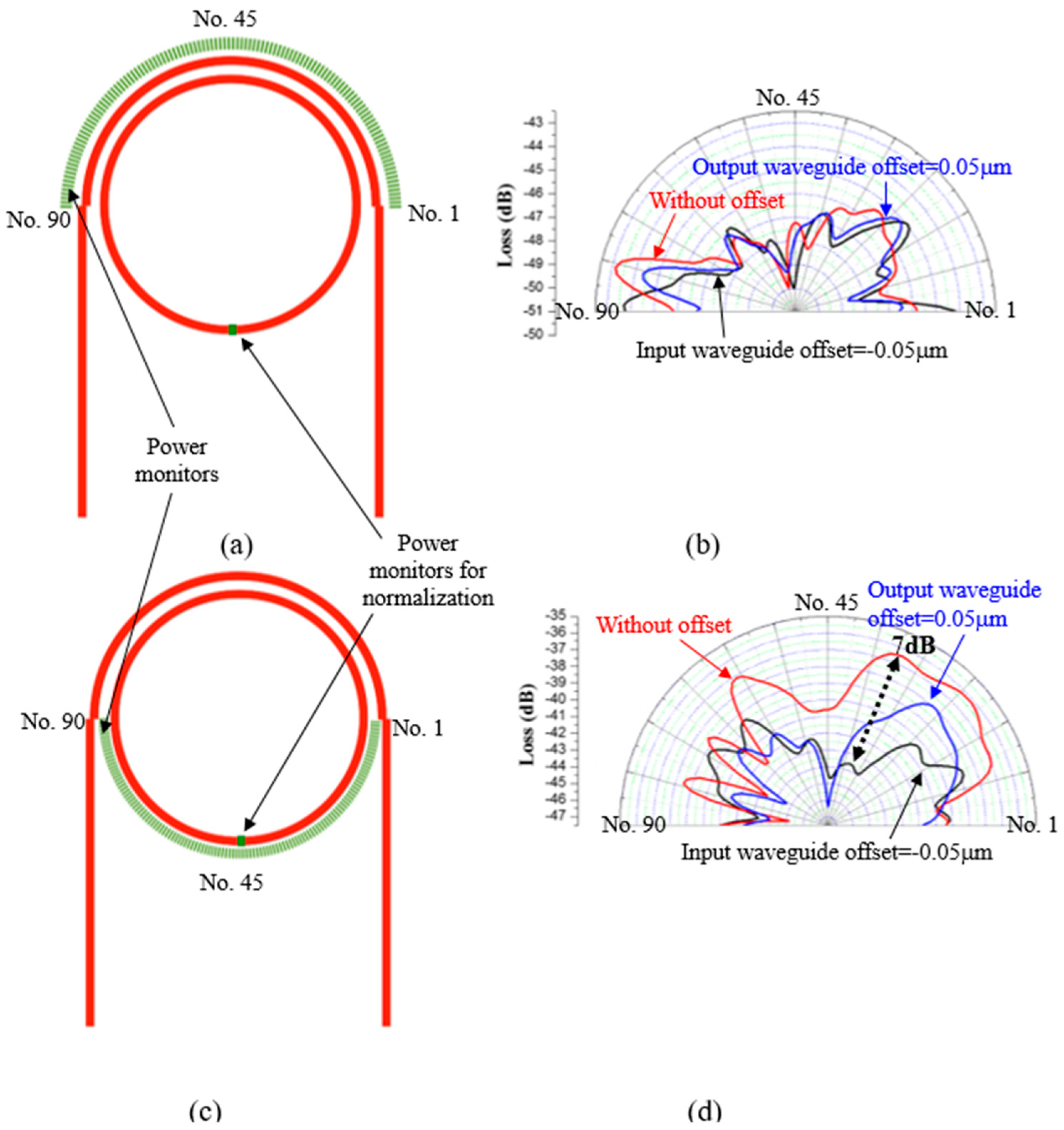Optimization of Pulley-Type Ring Resonator with Waveguide Offset
Abstract
:1. Introduction
2. Structure and Simulation Results
3. Optical Loss Analysis
4. Conclusions
Author Contributions
Funding
Conflicts of Interest
References
- Absil, P.P.; Hryniewicz, J.V.; Little, B.E.; Wilson, R.A.; Joneckis, L.G.; Ho, P.T. Compact microring notch filters. IEEE Photonic Technol. Lett. 2000, 12, 398–400. [Google Scholar] [CrossRef]
- Little, B.E.; Chu, S.T.; Haus, H.A.; Foresi, J.; Laine, J.P. Microring resonator channel dropping filters. J. Lightwave Technol. 1997, 15, 998–1005. [Google Scholar] [CrossRef]
- Almeida, V.R.; Barrios, C.A.; Panepucci, R.R.; Lipson, M. All-optical control of light on a silicon chip. Nature 2004, 431, 1081–1084. [Google Scholar] [CrossRef] [PubMed]
- Xiao, S.J.; Khan, M.H.; Shen, H.; Qi, M.H. A highly compact third-order silicon microring add-drop filter with a very large free spectral range, a flat passband and a low delay dispersion. Opt. Express 2007, 15, 14765–14771. [Google Scholar] [CrossRef] [PubMed]
- Xu, Q.F.; Schmidt, B.; Pradhan, S.; Lipson, M. Micrometre-scale silicon electro-optic modulator. Nature 2005, 435, 325–327. [Google Scholar] [CrossRef] [PubMed]
- Park, S.; Kim, S.S.; Wang, L.W.; Ho, S.T. Single-mode lasing operation using a microring resonator as a wavelength selector. IEEE J. Quantum Electron. 2002, 38, 270–273. [Google Scholar] [CrossRef]
- Matsuo, S.; Segawa, T. Microring-resonator-based widely tunable lasers. IEEE J. Sel. Top. Quantum 2009, 15, 545–554. [Google Scholar] [CrossRef]
- Krioukov, E.; Klunder, D.J.W.; Driessen, A.; Greve, J.; Otto, C. Sensor based on an integrated optical microcavity. Opt. Lett. 2002, 27, 512–514. [Google Scholar] [CrossRef] [PubMed]
- Chao, C.Y.; Guo, L.J. Design and optimization of microring resonators in biochemical sensing applications. J. Lightwave Technol. 2006, 24, 1395–1402. [Google Scholar] [CrossRef]
- Cho, S.Y.; Jokerst, N.M. A polymer microdisk photonic sensor integrated onto silicon. IEEE Photonic Technol. Lett. 2006, 18, 2096–2098. [Google Scholar] [CrossRef]
- Kiyat, I.; Kocabas, C.; Aydinli, A. Integrated micro ring resonator displacement sensor for scanning probe microscopies. J. Micromech. Microeng. 2004, 14, 374–381. [Google Scholar] [CrossRef]
- Fang, W.; Buchholz, D.B.; Bailey, R.C.; Hupp, J.T.; Chang, R.P.; Cao, H. Detection of chemical species using ultraviolet microdisk lasers. Appl. Phys. Lett. 2004, 85, 3666–3668. [Google Scholar] [CrossRef]
- Ashkenazi, S.; Chao, C.Y.; Guo, L.J.; O’Donnell, M. Ultrasound detection using polymer microring optical resonator. Appl. Phys. Lett. 2004, 85, 5418–5420. [Google Scholar] [CrossRef]
- Bhola, B.; Song, H.C.; Tazawa, H.; Steier, W.H. Polymer microresonator strain sensors. IEEE Photonic Technol. Lett. 2005, 17, 867–869. [Google Scholar] [CrossRef]
- Lehr, D.; Reinhold, J.; Thiele, I.; Hartung, H.; Dietrich, K.; Menzel, C.; Pertsch, T.; Kley, E.B.; Tünnermann, A. Enhancing second harmonic generation in gold nanoring resonators filled with lithium niobate. Nano Lett. 2015, 15, 1025–1030. [Google Scholar] [CrossRef] [PubMed]
- Lin, C.E.; Yen, T.J.; Yu, C.J.; Hsieh, C.M.; Lee, M.H.; Chen, C.C.; Chang, C.W. Singular observation of the polarization-conversion effect for a gammadion-shaped metasurface. Sci. Rep. 2016, 6, 22196. [Google Scholar] [CrossRef] [PubMed]
- Pornsuwancharoen, N.; Sangwara, N.; Yupapin, P.P. Generalized fast and slow lights using multi-state microring resonators for optical wireless links. Optik 2010, 121, 1721–1724. [Google Scholar] [CrossRef]
- Niehusmann, J.; Vörckel, A.; Bolivar, P.H.; Wahlbrink, T.; Henschel, W.; Kurz, H. Ultrahigh-quality-factor silicon-on-insulator microring resonator. Opt. Lett. 2004, 29, 2861–2863. [Google Scholar] [CrossRef] [PubMed]
- Goykhman, I.; Desiatov, B.; Levy, U. Ultrathin silicon nitride microring resonator for biophotonic applications at 970 nm wavelength. Appl. Phys. Lett. 2010, 97. [Google Scholar] [CrossRef]
- Menon, V.M.; Tong, W.; Forrest, S.R. Control of quality factor and critical coupling in microring resonators through integration of a semiconductor optical amplifier. IEEE Photonic Technol. Lett. 2004, 16, 1343–1345. [Google Scholar] [CrossRef]
- Poon, J.K.S.; Scheuer, J.; Xu, Y.; Yariv, A. Designing coupled-resonator optical waveguide delay lines. J. Opt. Soc. Am. B 2004, 21, 1665–1673. [Google Scholar] [CrossRef]
- Cai, D.P.; Lu, J.H.; Chen, C.C.; Lee, C.C.; Lin, C.E.; Yen, T.J. Compact pulley-type microring resonator with high quality factor. Appl. Phys. Express 2014, 7. [Google Scholar] [CrossRef]
- Cai, D.P.; Lu, J.H.; Chen, C.C.; Lee, C.C.; Lin, C.E.; Yen, T.J. High Q-factor microring resonator wrapped by the curved waveguide. Sci. Rep. 2015, 5. [Google Scholar] [CrossRef] [PubMed]
- Subramaniam, V.; DeBrabander, G.N.; Naghski, D.H.; Boyd, J.T. Measurement of mode field profiles and bending and transition losses in curved optical channel waveguides. J. Lightwave Technol. 1997, 15, 990–997. [Google Scholar] [CrossRef]
- Howley, B.; Wang, X.L.; Chen, R.T.; Chen, Y.H. Experimental evaluation of curved polymer waveguides with air trenches and offsets. J. Appl. Phys. 2006, 100. [Google Scholar] [CrossRef]
- Gu, Z.; Liu, S.; Sun, S.; Wang, K.; Lyu, Q.; Xiao, S.; Song, Q. Photon hopping and nanowire based hybrid plasmonic waveguide and ring-resonator. Sci. Rep. 2015, 5. [Google Scholar] [CrossRef]





© 2018 by the authors. Licensee MDPI, Basel, Switzerland. This article is an open access article distributed under the terms and conditions of the Creative Commons Attribution (CC BY) license (http://creativecommons.org/licenses/by/4.0/).
Share and Cite
Yen, M.-H.; Feng, P.-Y.; Lin, C.-E.; Chen, C.-C.; Chang, J.-Y. Optimization of Pulley-Type Ring Resonator with Waveguide Offset. Micromachines 2018, 9, 226. https://doi.org/10.3390/mi9050226
Yen M-H, Feng P-Y, Lin C-E, Chen C-C, Chang J-Y. Optimization of Pulley-Type Ring Resonator with Waveguide Offset. Micromachines. 2018; 9(5):226. https://doi.org/10.3390/mi9050226
Chicago/Turabian StyleYen, Meng-Hua, Pei-Yu Feng, Chu-En Lin, Chii-Chang Chen, and Jenq-Yang Chang. 2018. "Optimization of Pulley-Type Ring Resonator with Waveguide Offset" Micromachines 9, no. 5: 226. https://doi.org/10.3390/mi9050226




